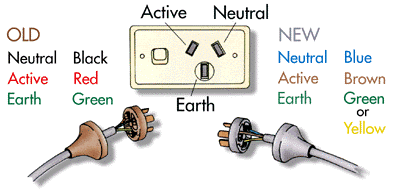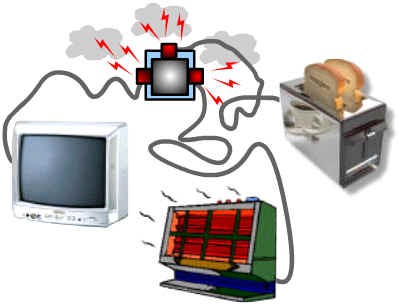Untangling the Workings of Electric Wiring for the Home Owner
It was all black inside. The wiring had melted, and that sour smell of burnt metal rose from the mess.
Placing the switchboard on the floor, Ramesh looked at Mr. Gupta and said, “Guptaji, I had asked you to use the better grade heat-resistant brand of electrical cable. But you didn’t listen to me saying it was unnecessarily expensive. Now it has caused you more damage.”
Ramesh wasn’t just referring to the cost of replacing the switchboard and redoing the wiring. He was talking about the damage to the wall-mounted LED Smart-TV, Split AC, and home theatre system.
He went on to explain what had happened.
The mains-supply to the house came through a three-core wiring system, called the live, neutral and the earth.  The brown active (or live or hot) wire brought in the current. The blue neutral wire took the current back. The green, or yellow, earth wire was a safety measure. It was connected to a metal-plate deep in the earth near the house. These wires supplied electricity to a 15amp circuit for appliances with higher power rating, and a 5amp circuit for those with lower ratings.
The brown active (or live or hot) wire brought in the current. The blue neutral wire took the current back. The green, or yellow, earth wire was a safety measure. It was connected to a metal-plate deep in the earth near the house. These wires supplied electricity to a 15amp circuit for appliances with higher power rating, and a 5amp circuit for those with lower ratings.
The current in a circuit (made of live and neutral  wire) depends on the connected appliances’ rating. Since the choice of wires wasn’t sufficient for the maximum current, it led to overloading. This was because the appliances’ total power-rating exceeded the permitted limit, and they drew a large current.
wire) depends on the connected appliances’ rating. Since the choice of wires wasn’t sufficient for the maximum current, it led to overloading. This was because the appliances’ total power-rating exceeded the permitted limit, and they drew a large current.
To make matters worse, there was direct contact between live and neutral wires due to the damage from overloading. And a very large current passed through causing a short circuit.
Ramesh clarified that wires and cables are quite different.
- A wire is a single conductor of electricity (made of copper or aluminium), i.e. the medium for passage or travel of current from source to use and vice versa. A wire could be bare, or insulated by a protective coloured covering.
- A cable, on the other hand, is two or more insulated wires wrapped in one jacket. Multiple conductors that have no insulation around would be classified as a single conductor.
- A wire could be solid or stranded. A solid wire is single and since it offers low resistance, is suitable for use in higher frequencies. A stranded wire is several strands of wires twisted together and inside a covering. Stranded wires are used where flexibility is important because the wire can be used for a longer period.
- If insulation on the wire is of low quality, it creates a safety hazard in the form of a fire or a short circuit. Hence, utmost care must be exercised while selecting the electric wires and cables.
Ramesh explained that as current passes through these wires, there is heat generated due to resistance. So, the wiring of the house should be suitable for high temperatures and carrying higher current. An insulating material that is Heat Resistant (HR) or Fire Resistant (FR) or Flame Retardant, Low Smoke (FRLS) helps the cable to withstand a fire, and safeguards the equipment connected to it.
Ramesh assured Mr. Gupta that the new electrical works and installations would conform to the latest safety standards, and that he would be using ISI-certified wires and cables. Ramesh’s preferred choice was Havells flexible cables, for their flame retardant and heat resistant properties, and as they could bear temperature up to 85o C and. Havells cables were lead-free and therefore non-toxic and environment friendly.
Other things he highlighted were:
- Carrying out wiring on distribution system
- Stopping the wiring from running above ceiling
- Not exceeding the load on circuit
- Fixing switch boards at proper height
- Using earth wiring of proper gauge
- Using copper conductors
- Not using damaged wiring or elements
- Installing standard length wires in the junction box
- Leaning adequate space between wires and the electric box or wooden frame
- Having separate holes for different electric lines
- Giving proper earthing to the wiring
As a professional electrician, Ramesh was recommending that Mr. Gupta focus on the specifications of the wiring of the house to will match his use (i.e. load) and safety standards. Because a wiring job well-done, meant fewer home electrical accidents, and fewer damage-control calls to him.

